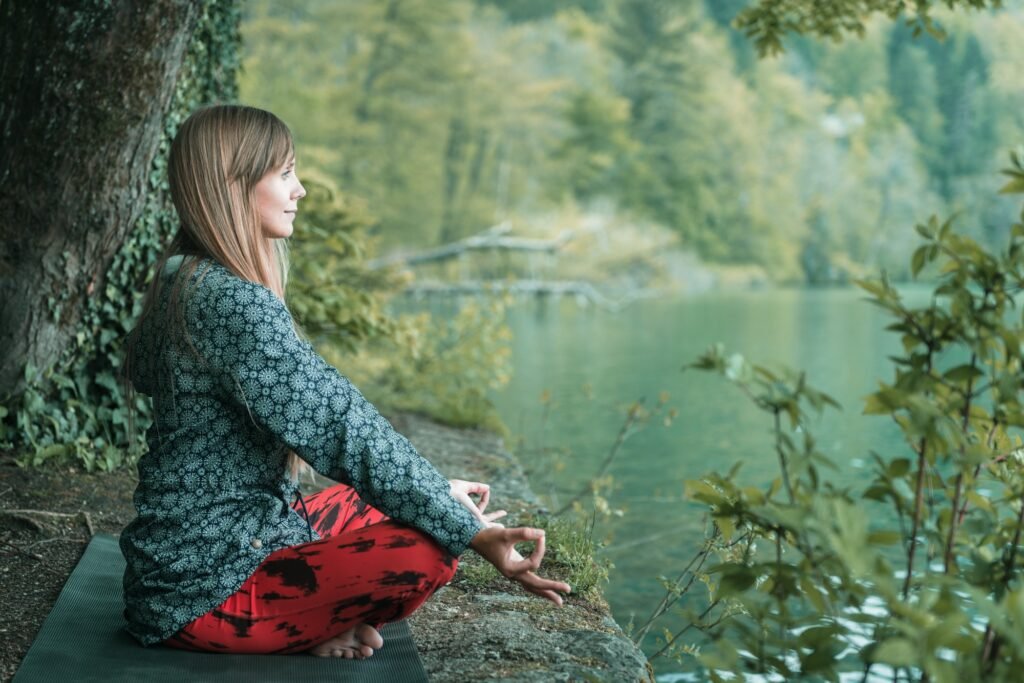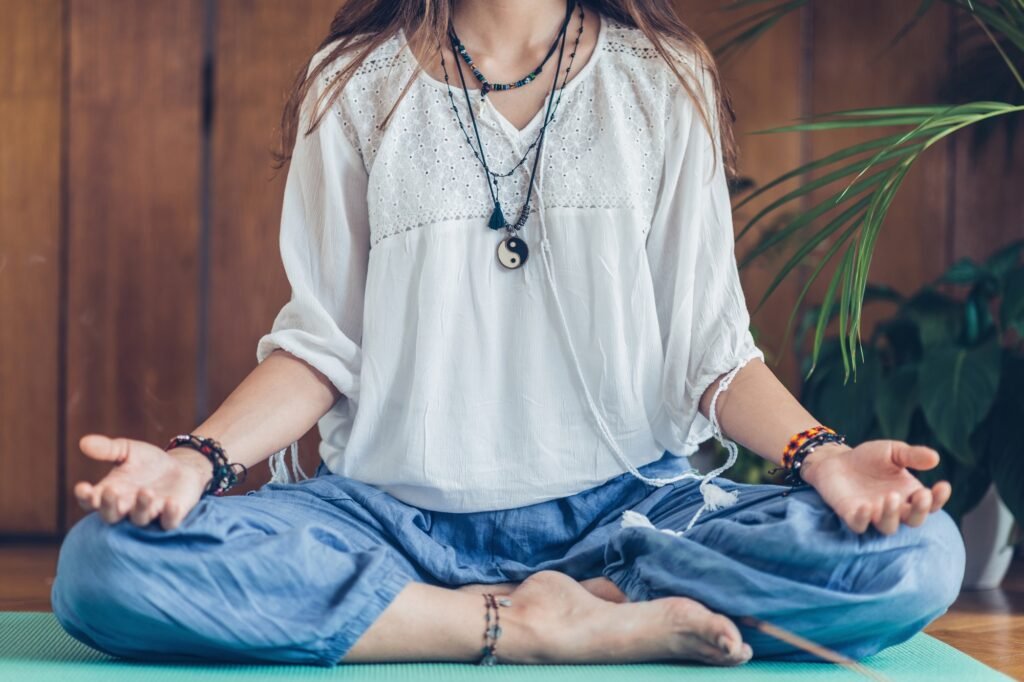Imagine waking up before dawn, surrounded by mountain mist, as ancient Sanskrit chants echo through the halls. This isn’t your typical yoga retreat – it’s a journey into the mystical world of Kundalini, where a dormant spiritual force awaits awakening at the base of your spine.
For thousands of years, seekers have pursued this powerful energy through dedicated practice and guidance. Today, Kundalini retreats offer a structured pathway to tap into this transformative power, combining traditional techniques with modern understanding to create profound shifts in consciousness.

Introduction to Kundalini
What is Kundalini? represents a sacred feminine energy that rests at the base of your spine in the root chakra. This potent force, whose name comes from the Sanskrit word meaning “coiled like a snake,” has been practiced in spiritual traditions for over 1,000 years.
When awakened, this dormant energy flows upward through your body’s energy centers, sparking spiritual growth and heightened awareness. Through specific practices like meditation, breathwork, and physical postures, practitioners work to activate and guide this inner power toward states of expanded consciousness.
The Purpose and Nature of Kundalini Retreats
A Beginner’s Guide to Kundalini retreats creates a focused environment for awakening your inner spiritual energy through intensive practice. Unlike typical yoga getaways that center on relaxation, these retreats specifically work with kundalini energy through specialized breathing techniques, meditation, and precise movement sequences.
The immersive experience can lead to profound spiritual breakthroughs, emotional healing, and a deeper connection to your inner self. You’ll learn tools to consciously manage energy while experiencing the transformative effects of sustained kundalini practices in a supportive setting.
Typical Retreat Structure and Daily Schedule
Your day at a kundalini retreat starts early, usually around 5:00 AM, with morning chanting. From there, you’ll move into kundalini yoga practice with specific movement sequences and breathing exercises. The morning flows into workshops on spiritual philosophy, followed by group meditation sessions.
Afternoons bring more gentle practices, like breathwork and energy-focused workshops. The day winds down with evening meditation and sound healing through gong baths. Your typical residential schedule allows for rest periods between sessions, giving you time to process the powerful energy work.

Activities to Expect
Key Spiritual Practices
You’ll start each session with the “Ong Namo Guru Dev Namo” chant, connecting to the lineage of teachers. Throughout the day, you’ll practice Breath of Fire, a rapid breathing technique that builds heat and energy. The fundamental Sat Kriya works with root lock while chanting “Sat Nam,” while spinal flexes wake up your central channel.
Rest and Integration
Between active sessions, you’ll experience deep relaxation through Yoga Nidra and gong baths. Silent meditation periods help you process the energy shifts, while guided body scans release built-up tension. These quieter practices balance the more intense kundalini techniques.
Healing Benefits
The combination of movement, sound, and breath directly affects your nervous system, helping release old patterns. Mantras create specific vibrations that work at a cellular level, while types of retreats target your glands and energy centers. Many find that emotional blocks naturally dissolve as kundalini energy moves through previously stuck areas.
Retreat Environments
Most kundalini retreats happen in spaces that support deep spiritual practice. Mountain settings offer pristine air and expansive views, while forest locations bring grounding energy. Some retreats take place in seaside spots where spring activities outdoors can refresh and clear energy.
The practice rooms feature clean, simple designs with plenty of natural light and good airflow. White walls and natural materials help keep your focus inward. Small groups of 12-20 people allow for personal attention, while larger gatherings of 40+ create powerful group energy fields.
These mindful spaces act like protective containers for your inner work. Being away from daily distractions lets your system settle into deeper awareness. The natural setting helps reset your energy patterns, while practicing alongside others makes spiritual experiences feel more normal and supported.
Expectations for Participants
Experience Levels
Most kundalini retreats welcome both beginners and experienced practitioners. Newcomers need basic physical fitness and a willingness to try new spiritual practices. More intensive retreats might ask for prior meditation experience or familiarity with breathwork. Advanced programs typically require an established kundalini practice and understanding of energy work.
Your Mental and Physical Readiness
You’ll need an open mind toward unfamiliar practices like chanting, energy movement, and group meditation. Physical challenges might include sitting for long periods or new movement patterns. Emotional releases often happen as energy shifts – tears, shaking, or spontaneous laughter are normal parts of the process.
Body Awareness
Listen carefully to your body’s signals during practices. Take breaks when needed rather than pushing beyond comfortable limits. Stay hydrated and rest between sessions if you feel overwhelmed. Let teachers know about any significant experiences or challenges you face. Find a balance between fun spring activities and gentle self-care.

Benefits of Participating in a Kundalini Retreat
Stress Relief and Mental Clarity
Regular kundalini practices switch on your body’s relaxation response, helping quiet an overactive mind. A Beginner’s Guide to Kundalini shows how focused breathing techniques soothe your nervous system, while meditation creates space between thoughts. Sound practices like chanting and gong baths bring your brain into more peaceful patterns. Many people find their mental fog lifts as tension melts away.
Emotional Release and Body Freedom
The practices often trigger deep emotional healing by moving stuck energy through your body. As you work through different postures, old emotional patterns can surface and release. Your body becomes more open and supple through gentle, systematic movements. The spine gains flexibility while joints and tissues receive fresh circulation.
Spiritual Growth and Nervous System Balance
Kundalini work opens doors to expanded awareness beyond everyday consciousness. The practices specifically target your intuitive abilities while building a stronger connection to your inner wisdom. Your nervous system learns to shift smoothly between activation and calm, building better stress resilience. The alternating techniques train your body to maintain balance even after the retreat ends.
How to Prepare Mentally
To make the most of your kundalini retreat experience, start practicing non-judgment about unfamiliar sensations now. Set clear intentions focused on growth rather than fixing perceived problems. Write these intentions down so you can revisit them during the retreat.
Let go of specific expectations about how your spiritual experiences “should” feel. Remember that everyone’s journey unfolds uniquely. Begin a daily journaling practice to build emotional awareness and learn simple self-soothing techniques to use if intense feelings arise.
Consider speaking with a therapist beforehand if you’re working through significant trauma.
What to Pack for a Kundalini Retreat
Clothing Essentials
Pack loose, white cotton clothing that lets you move freely. Choose long sleeves and pants for modesty during practice. Bring a head covering like a cotton bandana or scarf for meditation. Layer with a light shawl and warm socks for relaxation periods.
Personal Practice Items
Your mat, meditation cushion, and a cozy blanket form your practice foundation. Pack a small pillow for support, plus a journal and pens to record your experiences. Consider bringing mala beads for personal mantra work.
Daily Necessities
Keep a large water bottle handy to stay hydrated during intense practices. Pack natural toiletries, a tongue scraper, and essential oils like lavender for fun spring activities. Slip-on shoes make transitions easier between spaces.
Dietary Considerations
Common Meal Options
Most kundalini retreats serve vegetarian or vegan meals with whole foods. You’ll find brown rice, quinoa, fresh vegetables, legumes, and yogurt. Meals often start with a blessing and focus on light, energy-supporting foods. Some centers offer golden milk (turmeric milk) in the evenings to aid sleep and healing.
Getting Your Body Ready
Start cutting back on caffeine and processed foods 1-2 weeks before arrival. Add more plant-based options to your meals and drink plenty of water. Consider reducing portion sizes to match the lighter retreat meals. Taking probiotics can help if you have digestive concerns.
Why Water Matters
Your body needs extra water during kundalini practices, especially with breathwork. Sip room temperature water throughout the day rather than large amounts at once. Watch for signs of dehydration like headaches or fatigue. Consider adding electrolytes if you sweat heavily during practices.

Tips for Enhancing Your Experience
Preparing with Basic Practices
Start doing simple breathing exercises like long deep breaths 10-15 minutes daily. Practice basic spine warmups and gentle kriyas to ready your body. Pay attention to how your system responds and adjust accordingly. Keep sessions short and consistent rather than long and sporadic.
Learning the Sacred Sounds
Listen to recordings of “Sat Nam” and “Ong Namo Guru Dev Namo” mantras to learn proper pronunciation. Practice chanting privately to get comfortable with your voice. Understanding the meaning of these sacred sounds helps you connect more deeply during retreat sessions.
Rest Well Before Arrival
Start shifting to an earlier bedtime 1-2 weeks ahead if the retreat includes a typical residential schedule with dawn practices. Cut back on evening screen time to improve sleep quality. Plan to arrive a day early, if possible, to settle in. Take time off work beforehand to mentally decompress.
Post-Retreat Integration
Bringing Practices Home
Start with a 20-minute morning practice that fits your schedule. Choose 2-3 key techniques that moved you deeply during the retreat. Maybe it’s a simple breathing exercise, a specific meditation, or a gentle movement sequence. Add these gradually to your routine rather than trying to maintain retreat-level intensity.
Building Your Support System
Join local kundalini yoga classes to stay connected with like-minded people. Look for online communities where you can share experiences and ask questions. Some types of retreats offer virtual follow-up sessions or monthly check-ins. Consider finding a practice buddy who can keep you accountable.
Creating Sacred Space
Set up a quiet corner in your home with a meditation cushion, blanket, and meaningful objects from your retreat. This dedicated space helps trigger the peaceful state you experienced. Keep your journal nearby to track insights that surface as you continue practicing.
Embracing the Journey Home
The end of your Kundalini retreat marks the beginning of a deeper relationship with your practice and yourself. The tools, insights, and energetic shifts you’ve experienced aren’t meant to stay on the mountaintop – they’re seeds planted for continued growth in your daily life.
Remember that integration happens gradually, and every small step matters. Whether you’re maintaining a morning practice, connecting with fellow practitioners, or simply staying aware of your breath, you’re nurturing the awakening that began during your retreat. Trust the process and let your transformation unfold naturally.
